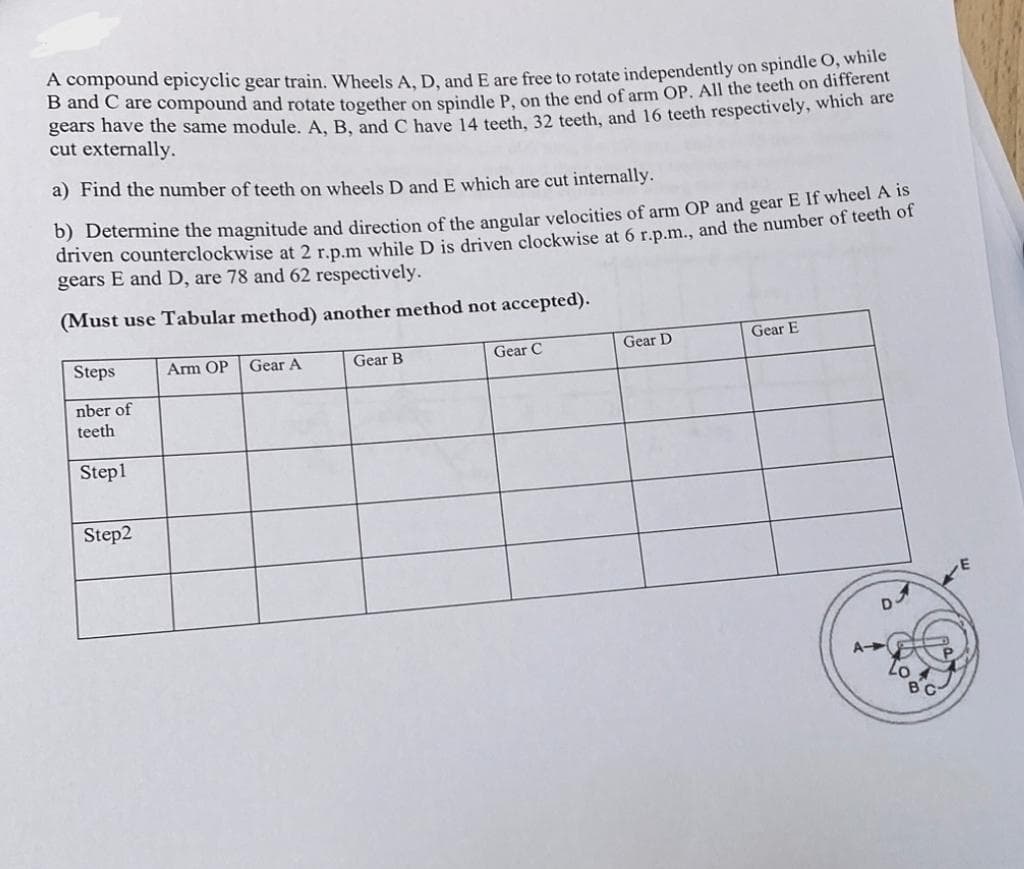A compound epicyclic gear train. Wheels A, D, and E are free to rotate independently on spindle O, while B and C are compound and rotate together on spindle P, on the end of arm OP. All the teeth on different gears have the same module. A, B, and C have 14 teeth, 32 teeth, and 16 teeth respectively, which are cut externally. a) Find the number of teeth on wheels D and E which are cut internally. b) Determine the magnitude and direction of the angular velocities of arm OP and gear E If wheel A is driven counterclockwise at 2 r.p.m while D is driven clockwise at 6 r.p.m., and the number of teeth of gears E and D, are 78 and 62 respectively. (Must use Tabular method) another method not accepted). Steps nber of teeth Step1 Step2 Arm OP Gear A Gear B Gear C Gear D Gear E DA
A compound epicyclic gear train. Wheels A, D, and E are free to rotate independently on spindle O, while B and C are compound and rotate together on spindle P, on the end of arm OP. All the teeth on different gears have the same module. A, B, and C have 14 teeth, 32 teeth, and 16 teeth respectively, which are cut externally. a) Find the number of teeth on wheels D and E which are cut internally. b) Determine the magnitude and direction of the angular velocities of arm OP and gear E If wheel A is driven counterclockwise at 2 r.p.m while D is driven clockwise at 6 r.p.m., and the number of teeth of gears E and D, are 78 and 62 respectively. (Must use Tabular method) another method not accepted). Steps nber of teeth Step1 Step2 Arm OP Gear A Gear B Gear C Gear D Gear E DA
Elements Of Electromagnetics
7th Edition
ISBN:9780190698614
Author:Sadiku, Matthew N. O.
Publisher:Sadiku, Matthew N. O.
ChapterMA: Math Assessment
Section: Chapter Questions
Problem 1.1MA
Related questions
Question

Transcribed Image Text:A compound epicyclic gear train. Wheels A, D, and E are free to rotate independently on spindle O, while
B and C are compound and rotate together on spindle P, on the end of arm OP. All the teeth on different
gears have the same module. A, B, and C have 14 teeth, 32 teeth, and 16 teeth respectively, which are
cut externally.
a) Find the number of teeth on wheels D and E which are cut internally.
b) Determine the magnitude and direction of the angular velocities of arm OP and gear E If wheel A is
driven counterclockwise at 2 r.p.m while D is driven clockwise at 6 r.p.m., and the number of teeth of
gears E and D, are 78 and 62 respectively.
(Must use Tabular method) another method not accepted).
Steps
nber of
teeth
Step1
Step2
Arm OP
Gear A
Gear B
Gear C
Gear D
Gear E
A
Expert Solution
This question has been solved!
Explore an expertly crafted, step-by-step solution for a thorough understanding of key concepts.
Step by step
Solved in 7 steps with 7 images

Knowledge Booster
Learn more about
Need a deep-dive on the concept behind this application? Look no further. Learn more about this topic, mechanical-engineering and related others by exploring similar questions and additional content below.Recommended textbooks for you

Elements Of Electromagnetics
Mechanical Engineering
ISBN:
9780190698614
Author:
Sadiku, Matthew N. O.
Publisher:
Oxford University Press

Mechanics of Materials (10th Edition)
Mechanical Engineering
ISBN:
9780134319650
Author:
Russell C. Hibbeler
Publisher:
PEARSON

Thermodynamics: An Engineering Approach
Mechanical Engineering
ISBN:
9781259822674
Author:
Yunus A. Cengel Dr., Michael A. Boles
Publisher:
McGraw-Hill Education

Elements Of Electromagnetics
Mechanical Engineering
ISBN:
9780190698614
Author:
Sadiku, Matthew N. O.
Publisher:
Oxford University Press

Mechanics of Materials (10th Edition)
Mechanical Engineering
ISBN:
9780134319650
Author:
Russell C. Hibbeler
Publisher:
PEARSON

Thermodynamics: An Engineering Approach
Mechanical Engineering
ISBN:
9781259822674
Author:
Yunus A. Cengel Dr., Michael A. Boles
Publisher:
McGraw-Hill Education

Control Systems Engineering
Mechanical Engineering
ISBN:
9781118170519
Author:
Norman S. Nise
Publisher:
WILEY

Mechanics of Materials (MindTap Course List)
Mechanical Engineering
ISBN:
9781337093347
Author:
Barry J. Goodno, James M. Gere
Publisher:
Cengage Learning

Engineering Mechanics: Statics
Mechanical Engineering
ISBN:
9781118807330
Author:
James L. Meriam, L. G. Kraige, J. N. Bolton
Publisher:
WILEY